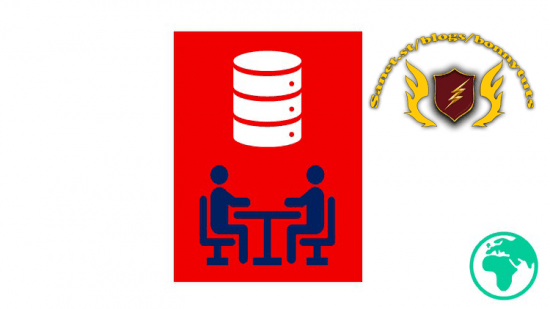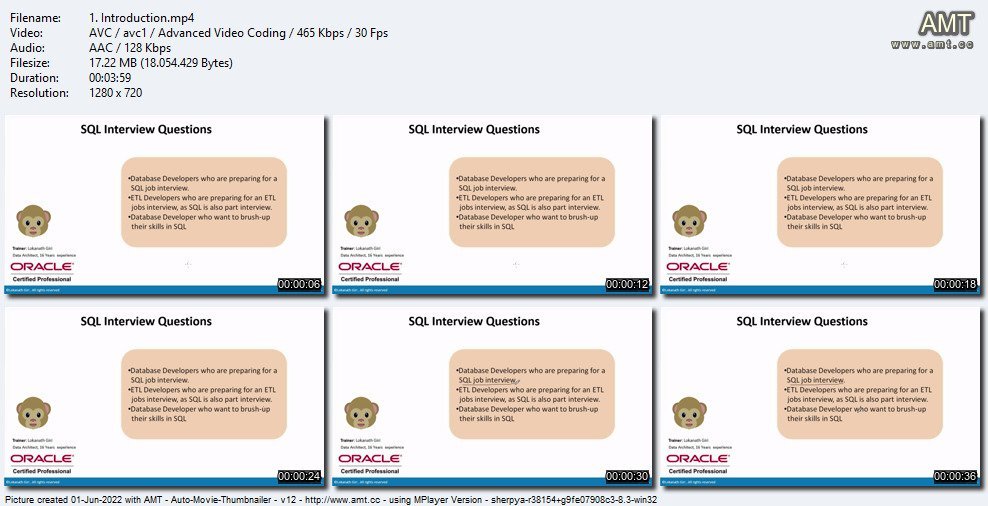
Last Updated 04/2021
MP4 | Video: h264, 1280×720 | Audio: AAC, 44.1 KHz, 2 Ch
Genre: eLearning | Language: English + srt | Duration: 79 lectures (6h 49m) | Size: 2.07 GB
150+ Interview questions | Tricky and Complex analytical queries | Real life examples !!
What you’ll learn
Oracle SQL Architecture Questions
SQL Tricky Queries
SQL Advanced Topic Questions
Questions from past 30+ Interviews
Instructor is a Oracle Certified Professional (OCP)
Instructor has Points: 12,975 Level: Master in Oracle Technology Network (OTN)
Requirements
Should have basic knowledge on database and SQL
I have attached Table and data scripts so please download and load the data so that you can practice.
Description
I have conducted more than 100+ Interviews.
Most importantly I myself attended 30+ interviews and kept the interview questions from different Interviewers.
That will be big boast to understand how different interviewer asked questions and what are the frequently asked questions
There are some tough queries / tricks so If you learn them mostly tough queries can be answered
Approximately 3 hours of lecture dedicated to write variety of SQL queries
If you are preparing for SQL Interview or an ETL developers add punch being a ETL + SQL pro-developer and answer most of SQL questions
There are around 150+ mostly asked questions from simple to expert level are discussed. It also includes 12C
<<<<<<<<<<
Learn SQL from an Architect who worked 16 years in SQL
An Oracle Certified Professions (OCP)
Oracle Technology Network (OTN) Points: 12,975 Level: Master
>>>>> >>>>>
Join the course and learn the important aspects and practical details of SQL and clear the interview with ease
I have kept related questions together so that one can easily memorize.
See you in the Class.
Course covered
Relational Database concepts
Explaining the theoretical and physical aspects of a relational database
Relating clauses in SQL Select Statement to Components of an ERD
Explaining the relationship between a database and SQL
Restricting and Sorting Data
Applying Rules of precedence for operators in an expression
Limiting Rows Returned in a SQL Statement
Using Substitution Variables
Using the DEFINE and VERIFY commands
Sorting Data
Using Conversion Functions and Conditional Expressions
Applying the NVL, NULLIF, and COALESCE functions to data
Understanding implicit and explicit data type conversion
Using the TO_CHAR, TO_NUMBER, and TO_DATE conversion functions
Nesting multiple functions
Displaying Data from Multiple Tables
Using Self-joins
Using Various Types of Joins
Using Non equijoins
Using OUTER joins
Understanding and Using Cartesian Products
Using SET Operators
Matching the SELECT statements
Using the ORDER BY clause in set operations
Using The INTERSECT operator
Using The MINUS operator
Using The UNION and UNION ALL operators
Managing Indexes Synonyms and Sequences
Managing Indexes
Managing Synonyms
Managing Sequences
Managing Views
Managing Views
Managing Objects with Data Dictionary Views
Using data dictionary views
Retrieving Data using the SQL SELECT Statement
Using Column aliases
Using The SQL SELECT statement
Using concatenation operator, literal character strings, alternative quote operator, and the DISTINCT keyword
Using Arithmetic expressions and NULL values in the SELECT statement
Using Single-Row Functions to Customize Output
Manipulating strings with character functions in SQL SELECT and WHERE clauses
Performing arithmetic with date data
Manipulating numbers with the ROUND, TRUNC and MOD functions
Manipulating dates with the date function
Reporting Aggregated Data Using Group Functions
Restricting Group Results
Creating Groups of Data
Using Group Functions
Using Subqueries to Solve Queries
Using Single Row Subqueries
Using Multiple Row Subqueries
Update and delete rows using correlated subqueries
Managing Tables using DML statements
Managing Database Transactions
Controlling transactions
Perform Insert, Update and Delete operations
Performing multi table Inserts
Performing Merge statements
Use DDL to manage tables and their relationships
Describing and Working with Tables
Describing and Working with Columns and Data Types
Creating tables
Dropping columns and setting column UNUSED
Truncating tables
Creating and using Temporary Tables
Creating and using external tables
Managing Constraints
Controlling User Access
Differentiating system privileges from object privileges
Granting privileges on tables
Distinguishing between granting privileges and roles
Managing Data in Different Time Zones
Working with CURRENT_DATE, CURRENT_TIMESTAMP and LOCALTIMESTAMP
Working with INTERVAL data types
Who this course is for
Database Developers who are preparing for a SQL interview.
ETL Developers who are preparing for a ETL jobs interview, as SQL is also part interview.
Database Developers who want to brush-up their skills in SQL

Password/解压密码www.tbtos.com
转载请注明:0daytown » Oracle SQL Interview Questions Master Class